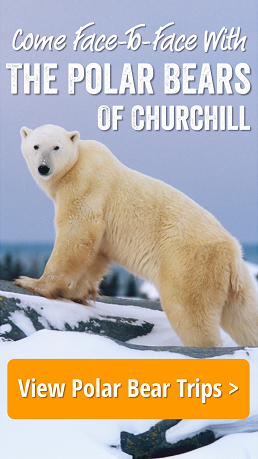by Steve Selden | Feb 20, 2011 | Tour News
The cold persevered through this past week ranging from -23c to -35c with wind chill feel of up to -55. Travelers with Natural Habitat Adventures and guide Karen arrived on the tail end of the previous week’s stormy front lingering in the Churchill region. Brrrrr-ave travelers from down South.
(more…)
by Steve Selden | Feb 13, 2011 | Tour News
A winter storm thrashed at the Churchill region over the past two days. Snowfall was not heavy though the winds were…driving blowing snow sideways and insuring the true low temperatures felt much colder- minus 55 C. Even Churchill has a threshold for cold as schools were forced to close to avoid frost-bitten little ones.
Via rail is in the process of refurbishing many of the old train cars so Guide Karen and her Natural Habitat group departed from Winnipeg with the fortune of having an observation dome car for their trip North to Churchill. Stars shone through on both nights affording a magnificent view of the incredibly clear arctic sky. As the train rumbled on in a Northerly direction, travelers were able to slow to the pace of the land and prepare themselves for their arctic adventure. What may have been the most punctual train to Churchill in the history of the Hudson Bay line; the locomotive chugged into Churchill at 5:58 am…actually early! Wow..the engineer must have been drinking Red Bull!
Welcomed by sideways -blowing snow, the group boarded a coach and headed for the hotel to settle in for some good ole arctic weather for the next three days. The Hudson Bay could not even be seen from the large window upstairs in the town complex….pretty thick. The grainery down at the port was barely visible as well.
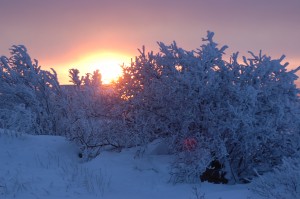
Break in the storm.
(more…)
by Steve Selden | Feb 8, 2011 | Tour News
Churchill once again is welcoming travelers from around the globe to witness the scintillating display of aurora borealis activity. The Churchill region provides optimal conditions, especially this time of year, for consistent, prolonged viewing of this amazing spectacle. Barring the dynamic cold temperatures, one can see the “Northern lights” with little interference in the sky in this special location on the Hudson Bay. Over the next three weeks I will post updates on the conditions and experiences of travelers in Churchill.
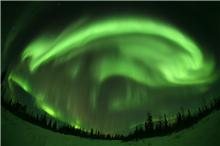
Photo: Eric Rock
For the Northern lights to occur, three distinct phenomena must come together. Luckily, in the skies over western Hudson Bay, this happens about two hundred and fifty days out of the year. (more…)
by Steve Selden | Feb 3, 2011 | Tour News
As winter has settled in to an up and down cycle of cold and colder, everything around has frozen and most life aside from the human population has come to a standstill. Temperatures are just below freezing again- considered a thaw by most Churchillians- though expected to dip again by weeks end into the -25C to -35C range. Sunrise is at 8:22 and sunset at 4:39…so the days are expanding grudgingly like the crusted ice pans in the Hudson Bay.

Photo: Steve Selden
While the omnipresent ravens appear all around Churchill, foxes-both red and arctic- also roam the tundra and town alleys searching for one more morsel of sustenance to get them through the chilled night. The braver, more adventurous of both species follow the polar bears out onto the Hudson Bay where food becomes available in the scraps of seal-kills by the massive bruins. These provide larger amounts of food at one time with much more exposure and risk coming along with the bounty. Weather is unforgiving out on the ice with little shelter other than the elevated pressure ridges formed from colliding ice floes. And then there’s the risk of getting too close to a bear and becoming an arctic home -run of sorts. Winter ball at its’ best.
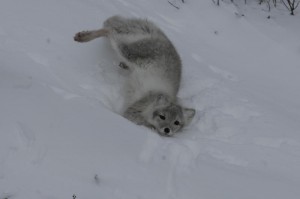
Photo: Paul Brown
So..that is why many of these beautiful critters opt to stay at home around Churchill , their home range, where food supply..living and non-living can be scavenged and shelter comes in a variety of forms.
Although the arctic North has traditionally been territory of the arctic fox, the red fox is winning the “evolutionary” tundra war so to speak. Arctic foxes are physically more prepared for the frigid elements in the North with a smaller body mass, fur lined soles of their feet, and apt white furry camouflage. They are the perfect species “team” on paper…the club that will endure forever and win the championship without playing the games. However, mother nature doesn’t work that way….and there is a scrappy contender in the picture now….the red fox.
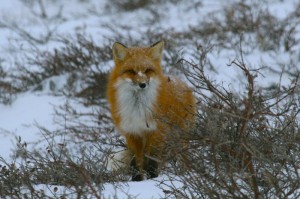
Photo: Paul Brown
The red fox has persevered without the tools of the arctic fox. Both have extensive similarities such as average lifespan of three to four years, gestation period of about 52 days, average litter size of between four and seven kits and similar denning aspects. Aside from the aforementioned upside of the arctic fox, the two species have alternated the territorial give and take. Now, however, there seems to be a distinct change in the fox hierarchy.
A couple of glaring changes in the ecosystem have allowed the red fox to gain ground on the arctic fox. Most notably is the hunting of the arctic fox. Because of the color, arctic fox pelts are more desirable for fur products such as clothing, boots and mittens. Also, hunting of the gray wolf – a premier predator of the red fox- has allowed the proliferation of the species in the North. Red foxes are already have the distinction of being the most widely distributed canid…ranging from the Arctic circle, through Asia and into North Africa… and they are extending their range at every opportunity.
About five years ago during Churchill’s polar bear season, there was a notable absence of arctic foxes. This void came after many bountiful years of the white fox abundance across the landscape. The word on the street was that the population was decimated by a rabies outbreak which tends to run rampant in the arctic species once contracted. Subsequent years saw red foxes dominate reported sightings by researchers, travelers and guides.
With all these variants stacked against the arctic fox, it will be interesting to see over the coming years if the slight increase in recent sightings is a trend toward recovery in the North or not. Only time will tell.
by Steve Selden | Jan 26, 2011 | Tour News
Two years ago in November, during polar bear season, Churchill was the center of the universe for something other than polar bear viewing.The spirit of the Olympics.
Sure, there’s the grain port ..an Arctic inland seaport that is supposed to become the premier link for grain export from Canada to the rest of the world. And of course the thousands of beluga whales in Summer are unmatched when it comes to a wildlife experience. And, in November we all know what takes center stage. But these are things or experiences that are Churchill and will forever be Churchill….let’s hope anyway. What came to Churchill that November day was something so real in spirit but quite possibly unattainable in reality.
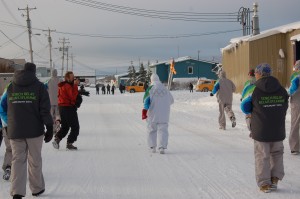
Photo: Steve Selden
On November 8, 2009 the Olympic games ceremonial torch appeared out of the snowy, frigid air on Kelsey Boulevard. One could feel the anticipation in the air as we all waited for the delayed torch to appear from the airport and into town. Once arrived, it was ushered around Churchill and down behind the town complex where the bearer boarded a tundra rover and gazed out over the Hudson bay. Snow and cold made that morning all the more memorable though the real memory will be the feeling that came with the torch to this tiny frontier town on the Hudson bay.

Photo: Steve Selden
Innocence and purity are words that come to mind when I think of that day as I fervently followed the torch from place to place snapping photo’s with freezing fingers. I had been to the Winter Olympics of 2002 in Salt Lake City, Utah and will never forget the feeling of world unity through competition. The indescribable feeling that we are one people can be felt at the Olympic games for that far too short period of two weeks. You become isolated in a bubble of hope and belief that there is possibly a solution to countries fighting over land and ideals that does not end in war. It’s euphoric and hopeful.
I felt that again..even more-so, in the town I had spent a good amount of my life in over the past ten years- most likely because Churchill to a large extent is innocent and removed from the worldly pain that takes place each day. It is surely removed geographically …if the predominant gales were from the South instead of North, the town itself would slide across the frozen tundra and disappear into the steely Hudson Bay. Not to say they don’t have their human turmoil like every place; but comparably Churchill is a safe haven for the most part. The torch, on that November day, became one with the town and the hope of peace and freedom in the world. It’s a feeling I cannot explain to you in adequate words ..though you would know it if you felt it. It’s the embodiment of the Olympic spirit and the hope it holds for mankind and future generations to settle disputes peacefully.

Photo: Steve Selden
by Steve Selden | Jan 21, 2011 | Tour News
Polar bears are out on the ice in the Hudson Bay hunting seals. At least in the Western Hudson Bay. The Eastern coast and extending out some distance has been lacking in ice as a result of weather patterns, currents and an unusually late freeze-up in the bay overall. As a result bear population on the Western half is more saturated.

Photo: Steve Selden
The weather is settling back into normal, frigid Winter conditions as mentioned in my last post. Despite some Churchillians claim that this winter has been “warm”..yes warm, the temperatures are currently in the -30C range almost daily. The outlook for the next week or so is for the mercury to drop close to -50C with winds of 60 kilometers …more like the mean for January in the North. With extended cold such as this, the Eastern Hudson Bay should play catch -up fairly quickly. Seal populations should remain steady as they will still have ample birthing platform available to the West. This condensed area could be opportunity for polar bears to have a solid Winter of energy storage. Should be interesting to observe their weights this Summer.

Photo: Steve Selden
With the good also comes..well…the not so good. Unless your an Inuit hunter holding a polar bear tag this Winter. Hunting around Baffin Island and the Davis Straits has commenced with quotas increased this year. Limits on takes have increased from 16 males and seven females to 32 males and nine females. The Inuit contend that unused tags from previous years are being totaled for this year’s limit rather than an increase in quota overall. I’ll dig up more information on this and keep you all informed in future posts. It will be interesting to see how ice conditions factor into this year’s hunt as well.
CBC News Story On Iqaluit Polar Pear Quota Increase













